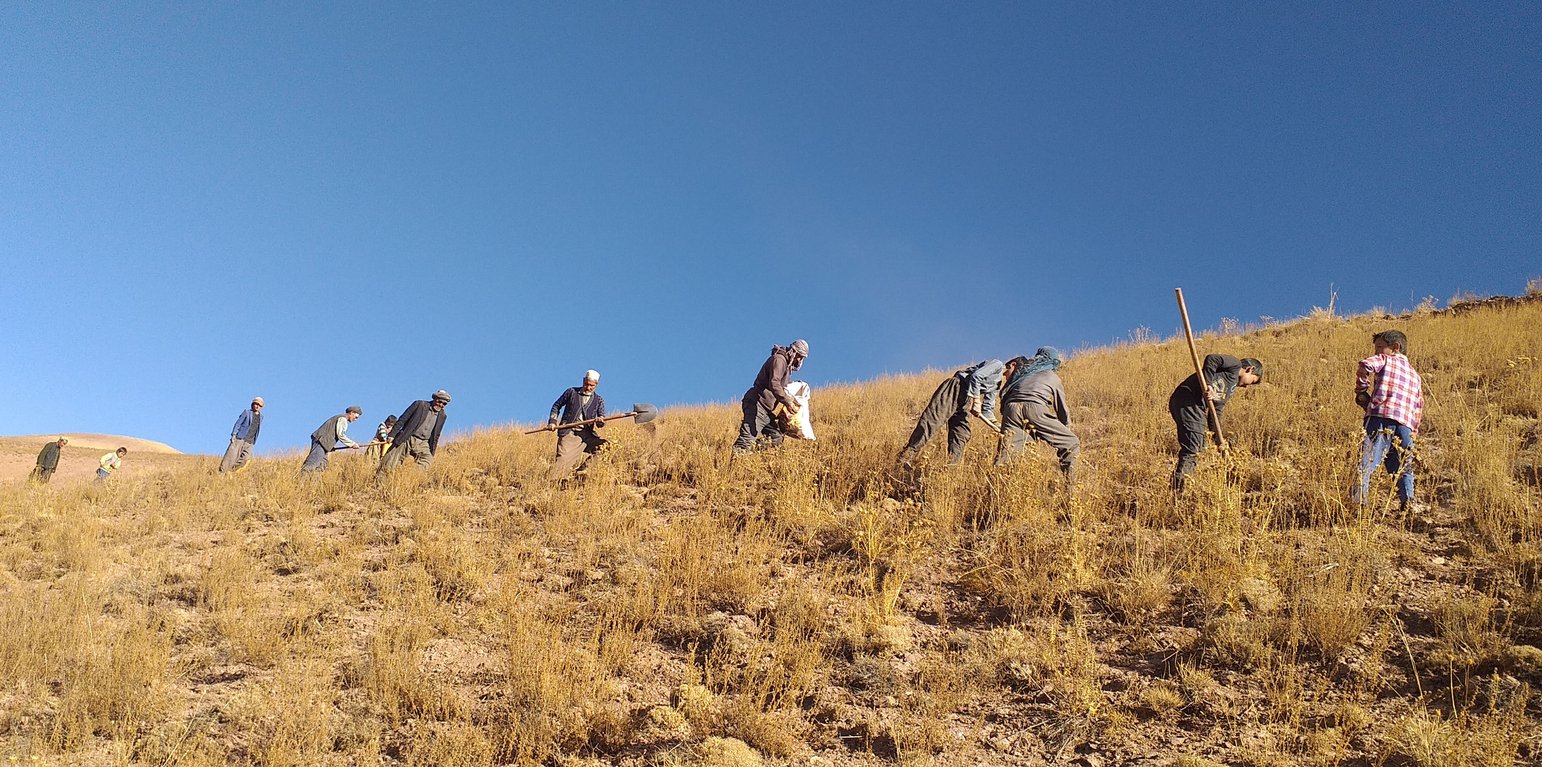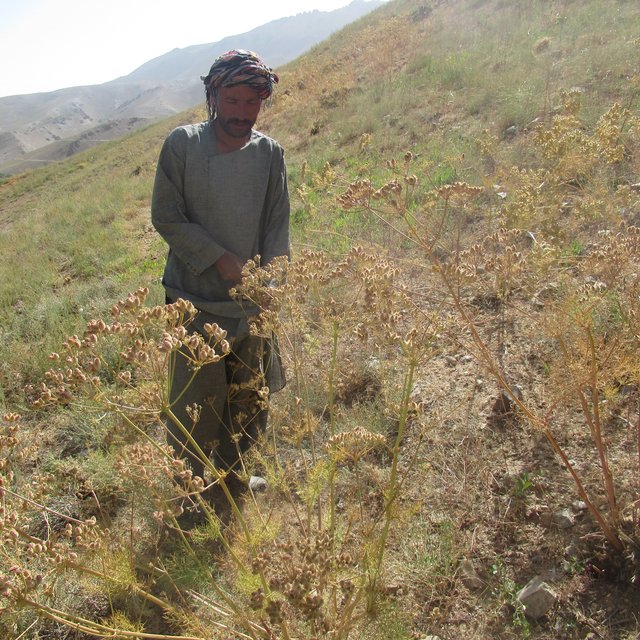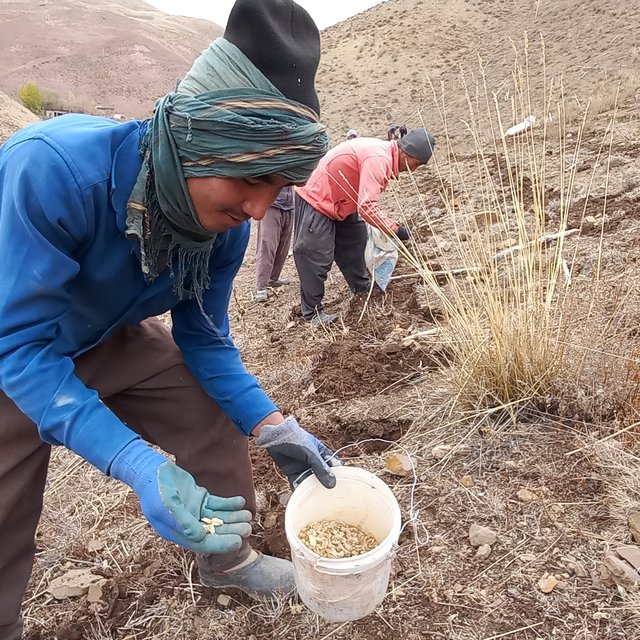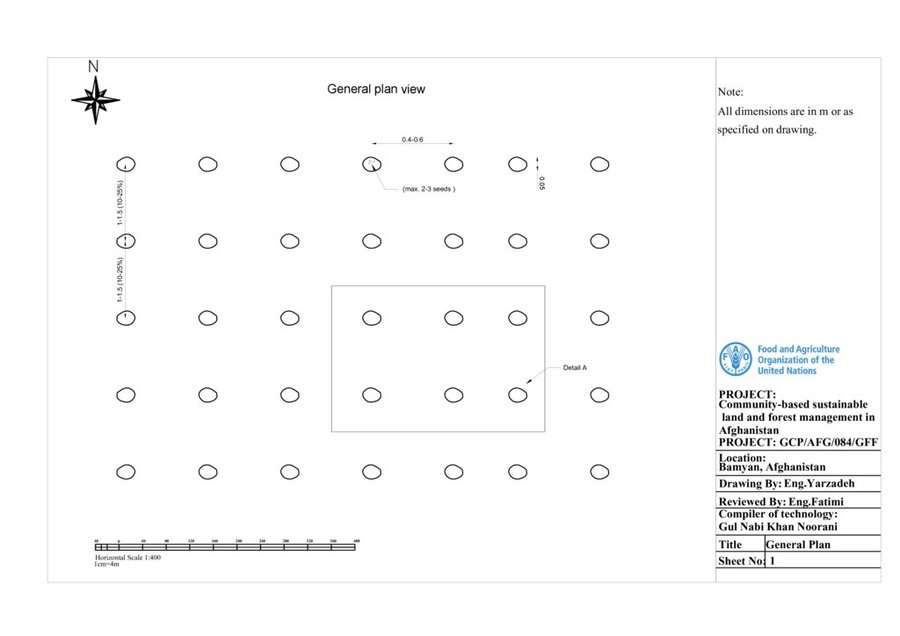



The Food and Agriculture Organization (FAO) project of “Community-based sustainable land and forest management in Afghanistan” aimed to conserve vegetation cover and ecosystems through introducing community-based sustainable land and forest management (SLM/SFM) practices in rangeland and forest areas within five targeted provinces, including Bamyan, that benefited rural communities that rely on these ecosystems for their livelihood. The project introduced an integrated, community-based approach of SLM/SFM in Afghanistan for promoting biodiversity conservation, climate change mitigation, and rangeland productivity.
To enhance rangeland productivity in Bamyan province, artificial reseeding of native, locally adapted, and drought-resistant fodder species plays a vital role in restoring health and productivity of the degraded rangeland ecosystem, improving soil quality, and increasing fodder availability for livestock, which contributed to local livelihoods and environmental resilience.
Communities carefully identify highly vulnerable and degraded rangelands for reseeding initiatives. These include previously rain-fed wheat fields cultivated for human consumption, overgrazed sites, and areas with restricted grazing to support vegetation recovery before reseeding. Attention is also given to areas prone to snow avalanches and flash floods causing landslides and soil erosion, which impact downstream residential areas, irrigation systems, trails, roads, and farmlands. These zones are prioritized and mutually agreed upon for reseeding and restoration efforts.
This reseeding local fodder species technology involves several key activities.
1.Identification of locally adapted drought-resistant and palatable fodder species by livestock owners and land users.
2.Identification of highly producing areas of selected fodder species to collect quality seeds.
3.Defer grazing and delay fodder harvest for the purpose of seed maturity in the targeted area.
4.Awareness raising about the maturity stages of different fodder species seeds: Through project intervention and awareness campaigns, rural residents have gained a better understanding of the seed ripening, collecting, and cultivation stages.
5.Collecting, drying, and storing seed: The fodder species’ seeds are collected manually by hand. These fodder species produce longer main stems with inflorescence and spikelets on the top at an average person's breast height. Collected seed is brought to the storing facility and laid out under sunlight for drying. Once seed reaches a certain moisture content, it's stored in a cool and dry place until the day of reseeding under the direct supervision of the rangeland management association (RMA).
6.Season of reseeding local fodder seed: Reseeding activities typically begin in the autumn season, just before the first snowfall. Seeds remain in the soil throughout the winter, allowing them to overcome dormancy and germinate in the spring of the following year. Local fodder species used for reseeding include various Fennel species and other plants traditionally relied upon for winter fodder. These include: Umbelliferae ferulus (Gheghu), Winklera silaifolia (Pali), Prangos sp. (Kami), Ferula sp. (Badran), Rheum spp. (Chukri), Koeleria cristata (Khola), a shrub locally known as Qarghna.
7.Method of Reseeding: The inter and intra-row space between seeding pits (max. 2-3 seeds in one pit) depends on the slope of the terrain, canopy of the fodder, and extent of vegetation cover. If the % slope of the terrain is increasing and canopy of planted species is small, then the space between two rows and two plants decreases and vice versa. Normally, the space between two rows is 1-1.5 m and two plants are about 40-60 cms apart. On the day of reseeding, some land users dig small pits using a hoe and shovel approximately five centimeters deep, followed by another person who puts seeds in the pit and covers the seed with soil using his own boot. The distance between pits is estimated through a person's step. One person reseeds 3.5 kgs of seed per working day. Roughly, a total of 15 kgs of fodder seed is needed for 1 ha of rangeland. It's worth mentioning that the quantity of seed per ha depends on the space between rows and plants and the size of the fodder seed itself.
The seeds are collected using the cash-for-work model. This served (i) to provide income support to poor, vulnerable men and women through short-term employment and (ii) to rehabilitate public assets (rangelands) that are vital for sustaining the livelihoods of livestock rearing. Both men and women-headed vulnerable households benefited from the cash-for-work program of seed collection. More importantly, these fodder species’ seeds are fresh, locally adapted, nutritious for livestock (help fatten livestock), available locally, and inexpensive compared to other types of fodder seed. The germination percentage of the seed and growth of the fodder is significantly high in the reseeded area.
Traditionally, rural communities knew that fodder crops grew from seeds; however, the main stems with inflorescences and spikelets were harvested before maturity and used as fuelwood for heating and cooking. Through awareness-raising campaigns and training workshops within the project, farmers were encouraged to leave the main stems intact for seed maturation, allowing for natural seed dispersal and seed collection for reseeding. The success of natural reseeding is limited compared to artificial reseeding due to several factors. In natural reseeding, seeds are often exposed and not covered by soil, making them vulnerable to environmental conditions. Moisture availability may also be insufficient for germination, and existing vegetation can compete with new growth. In contrast, artificial reseeding ensures that seeds are properly covered, protected, and placed in areas with optimal moisture, which increases the likelihood of successful germination and establishment. Recently, the demand for the local fodder seed has dramatically increased because many non-profit organizations and private businesses are purchasing these seeds. It created a new source of income for the rural communities.
Finally, the technology combines both traditional knowledge and scientific understanding, contributing to more effective restoration of the degraded rangeland ecosystem, improving soil health, and increasing fodder availability, which contributed to livelihood resilience and improvement.

Байршил: Punjab and Yakawalang districts, Bamyan, Афганистан
Дүн шинжилгээнд хамрагдсан технологи нэвтрүүлсэн газрын тоо: 10-100 байршилд
Технологийн тархалт: тодорхой газар хэрэгжсэн/ жижиг талбайд төвлөрсөн
Тусгай хамгаалалттай газар нутагт?: Үгүй
Хэрэгжилтийн огноо: 2021
Нутагшууллын төрөл


| Төрөл зүйл | Тоо хэмжээ |
| хонь | 647703 |
| ямаа | 250869 |
| үхрийн аж ахуй - цагаан идээ | 165274 |





| Зардлын нэр, төрөл | Хэмжих нэгж | Тоо хэмжээ | Нэгжийн үнэ (AFN) | Зардал бүрийн нийт өртөг (AFN) | Нийт дүнгээс газар ашиглагчийн төлсөн % |
| Хөдөлмөр эрхлэлт | |||||
| Collecting of local fodder seed (Kami, Ghegho, Chukri, Khola, Badra, Qarghana) | person-days | 5.0 | 350.0 | 1750.0 | |
| Drying and storing of local fodder seed | person-days | 3.0 | 350.0 | 1050.0 | |
| Reseeding of local fodder seed in rangeland | person-days | 8.0 | 350.0 | 2800.0 | 100.0 |
| Тоног төхөөрөмж | |||||
| Pit digging equipment i.e., shovel, hoe, pick mattock | no. | 5.0 | 250.0 | 1250.0 | 100.0 |
| Plastic bags for collecting seed (reusable) | pieces | 3.0 | 20.0 | 60.0 | 100.0 |
| Технологи бий болгох нийт үнэ өртөг | 6'910.0 | ||||
| Технологи бий болгох нийт үнэ өртөг, ам.доллар | 100.14 | ||||
| Зардлын нэр, төрөл | Хэмжих нэгж | Тоо хэмжээ | Нэгжийн үнэ (AFN) | Зардал бүрийн нийт өртөг (AFN) | Нийт дүнгээс газар ашиглагчийн төлсөн % |
| Хөдөлмөр эрхлэлт | |||||
| Community members, acting as rangers, patrol the area to control grazing, fodder collection, and shrub harvesting | person-day | 240.0 | 200.0 | 48000.0 | 100.0 |
| Reseeding of pits where there was no germination. | person-day | 2.0 | 350.0 | 700.0 | 100.0 |
| Conduct awareness raising for herders on SLM. | no. | 3.0 | 3000.0 | 9000.0 | |
| Технологийн арчилгаа/урсгал үйл ажиллагаанд шаардагдах нийт үнэ өртөг | 57'700.0 | ||||
| Технологи арчилах ба урсгал ажлын нийт үнэ өртөг, ам.доллар | 836.23 | ||||
Access to services and infrastructure in Bamyan Province is limited due to its remote location and mountainous terrain. Basic services such as healthcare, education, and clean water are available but often insufficient, particularly in rural areas. Infrastructure like roads and electricity is underdeveloped.
ГТМ хэрэгжихээс өмнөх тоо хэмжээ: 560 Kg/hectare
ГТМ хэрэгжиснээс хойшхи тоо хэмжээ: 1050 kg/hectare
The fodder production per hectare in Bamyan’s rangelands varies significantly based on land conditions and management practices. In rehabilitated rangelands, such as those supported by FAO projects, forage production enhanced through reseeding and rotational grazing strategies.
ГТМ хэрэгжихээс өмнөх тоо хэмжээ: 6 litters milk/cow/day
ГТМ хэрэгжиснээс хойшхи тоо хэмжээ: 12 litters milk/cow/day
The integration of indigenous and scientific fodder production techniques (reseeding of local fodder) and availability of nutritious fodder has boosted both health and livestock productivity sustainably.
ГТМ хэрэгжихээс өмнөх тоо хэмжээ: 0
ГТМ хэрэгжиснээс хойшхи тоо хэмжээ: 539 hectares
The fodder producing area has been increased from zero to hunderd hectares of rangeland.
ГТМ хэрэгжихээс өмнөх тоо хэмжээ: 5 liters/minute (discharge of spring)
ГТМ хэрэгжиснээс хойшхи тоо хэмжээ: 11 liters/minute (discharge of spring)
Reseeding and improving vegetation cover on rangelands significantly enhanced the infiltration of rainfall and snowmelt, ultimately benefiting underground water reserves and increasing the availability of animal drinking points, irrigation water and drinking water sources such as spring.
ГТМ хэрэгжихээс өмнөх тоо хэмжээ: Potato cultivation and Livestock
ГТМ хэрэгжиснээс хойшхи тоо хэмжээ: Potato cultivation, livestock and seed collection
RMA members now harvest fodder seeds once they reach maturity and sell them in the market, contributing to both local livelihoods (income) and the sustainability of rangeland management.
ГТМ хэрэгжихээс өмнөх тоо хэмжээ: Zero community institution
ГТМ хэрэгжиснээс хойшхи тоо хэмжээ: 7 rangeland management associations (RMAs)
The community institutions in the area are primarily organized as Rangeland Management Associations (RMAs).
ГТМ хэрэгжихээс өмнөх тоо хэмжээ: Zero capacity building workshop
ГТМ хэрэгжиснээс хойшхи тоо хэмжээ: Capacity of 10,000 RMA's member build.
The capacity of RMA members is enhanced through training, community-based workshops, and awareness-raising initiatives focused on Sustainable Land Management (SLM) and Sustainable Forest Management (SFM).
ГТМ хэрэгжихээс өмнөх тоо хэмжээ: 4 conflicts / village/year
ГТМ хэрэгжиснээс хойшхи тоо хэмжээ: 0 conflicts/village/year
Increasing the quantity and availability of water and fodder helps reduce conflicts by addressing resource scarcity, which is often a source of tension. When communities have enough access to these essential resources, competition decreases, and cooperation can grow.
ГТМ хэрэгжихээс өмнөх тоо хэмжээ: 30-40%
ГТМ хэрэгжиснээс хойшхи тоо хэмжээ: 70-80%
Reseeding improves soil cover, protecting it from erosion, stabilizing the soil, enhancing water retention, and restoring nutrients. This supports ecosystem recovery and promotes healthier soils and sustainable land use.
ГТМ хэрэгжихээс өмнөх тоо хэмжээ: 40-50%
ГТМ хэрэгжиснээс хойшхи тоо хэмжээ: 0
Soil loss varies depending on topography, land use, and management practices. Soil loss rates typically range between 2.2 to 38 tons per hectare per year (t/ha/year), depending on slope steepness and vegetation cover. Higher rates are observed in areas with steep terrain and minimal vegetation, while conservation practices can reduce these rates significantly.
ГТМ хэрэгжихээс өмнөх тоо хэмжээ: 30-40%
ГТМ хэрэгжиснээс хойшхи тоо хэмжээ: 70-80%
Reseeding improved vegetation coverage by introducing new plant seeds to degraded areas, promoting their regrowth and restoring ecosystems.
ГТМ хэрэгжихээс өмнөх тоо хэмжээ: 0.2-2 Ton/hectare
ГТМ хэрэгжиснээс хойшхи тоо хэмжээ: 4-5 ton/hectare
Reseeding local fodder seeds in rangelands enhances aboveground biomass carbon by increasing vegetation growth, which sequesters more carbon.
ГТМ хэрэгжихээс өмнөх тоо хэмжээ: 5-15 species/species/square meter
ГТМ хэрэгжиснээс хойшхи тоо хэмжээ: 15-25 species/species/square meter
Plant diversity is relatively high, featuring a variety of native grasses, shrubs, and medicinal plants adapted to the region's arid and semi-arid conditions. The plant diversity can vary widely depending on factors like altitude, grazing pressure, and management practices.
ГТМ хэрэгжихээс өмнөх тоо хэмжээ: 0
ГТМ хэрэгжиснээс хойшхи тоо хэмжээ: 2-5 species/ technology area
Bees and birds
ГТМ хэрэгжихээс өмнөх тоо хэмжээ: 2-3 floods / year
ГТМ хэрэгжиснээс хойшхи тоо хэмжээ: 0 floods/year
Reseeding reduces flooding by establishing vegetation cover that stabilizes the soil, enhances water infiltration, and slows surface runoff, thus decreasing the volume and velocity of water that can lead to floods.
ГТМ хэрэгжихээс өмнөх тоо хэмжээ: 50,000 m3/winter season
ГТМ хэрэгжиснээс хойшхи тоо хэмжээ: 5000 m3/winter season
Reseeding helps reduce landslides by promoting the growth of vegetation, the roots bind soil particles together, increasing slope stability and reducing soil erosion caused by water runoff and snow fall.
ГТМ хэрэгжихээс өмнөх тоо хэмжээ: 560 Kg/hectare (fodder yield)
ГТМ хэрэгжиснээс хойшхи тоо хэмжээ: 1050 kg/hectare (fodder yield)
Reseeding of different fodder species enhances soil moisture retention, reduce surface evaporation, and improve water infiltration.
ГТМ хэрэгжихээс өмнөх тоо хэмжээ: 5 liters/minute (discharge of spring)
ГТМ хэрэгжиснээс хойшхи тоо хэмжээ: 11 liters/minute (discharge of spring)
Reseeding and improving vegetation cover enhanced the infiltration of rainfall and snowmelt, ultimately benefiting ground water recharge and increasing water availability: animal drinking points, irrigation water and drinking water sources such as springs.
ГТМ хэрэгжихээс өмнөх тоо хэмжээ: 2-3 floods/year
ГТМ хэрэгжиснээс хойшхи тоо хэмжээ: 0 floods/year
Vegetation cover stabilizes the soil, enhances water infiltration, and slows surface runoff, thus decreasing the volume and velocity of water that can lead downstream floodsing and damage.
ГТМ хэрэгжихээс өмнөх тоо хэмжээ: 2-3 floods/year
ГТМ хэрэгжиснээс хойшхи тоо хэмжээ: 0 floods/year
Reseeding helps reduce downstream siltation and river water pollution by stabilizing the soil, preventing erosion, and promoting the growth of vegetation that intercepts and filters runoff.
Reseeding helped increase buffering and filtering capacity by reintroducing vegetation that acts as a natural barrier against pollutants and runoff. The plant roots stabilize the soil, reducing erosion, while the vegetation cover slows water movement, allowing it to infiltrate the ground.
ГТМ хэрэгжихээс өмнөх тоо хэмжээ: 2-3 floods/year
ГТМ хэрэгжиснээс хойшхи тоо хэмжээ: 0 floods/year
Reseeding and better soil cover helped reduce flash flood damage to neighboring agricultural fields downstream.
ГТМ хэрэгжихээс өмнөх тоо хэмжээ: 0.5-2 tons of sequestered CO₂/ hectare annually
ГТМ хэрэгжиснээс хойшхи тоо хэмжээ: 3-4 tons of sequestered CO₂/ hectare annually
Reseeding reduces greenhouse gases by enhancing carbon sequestration in plants and soil, while also minimizing emissions of nitrous oxide and methane from degraded areas.